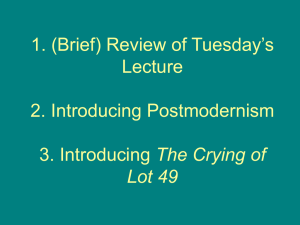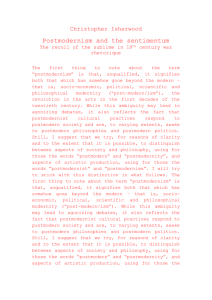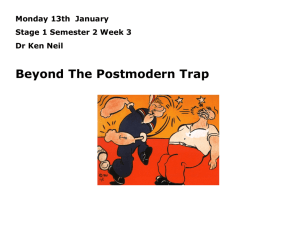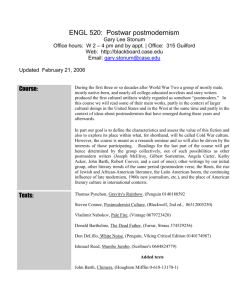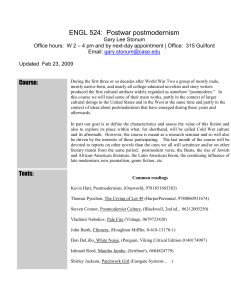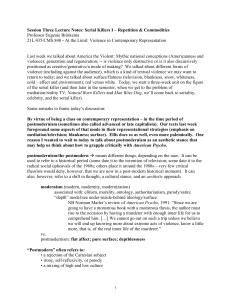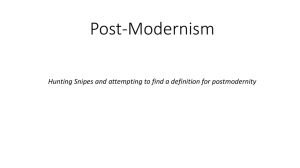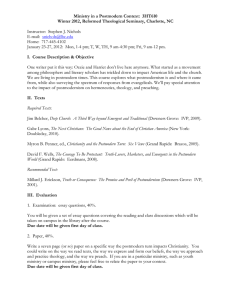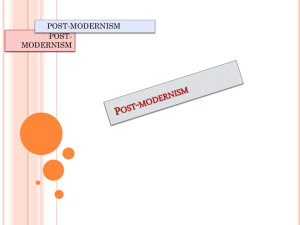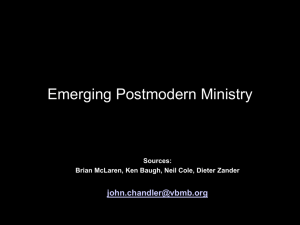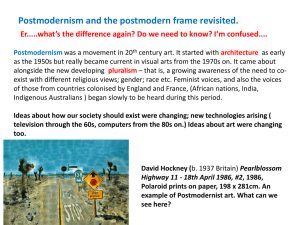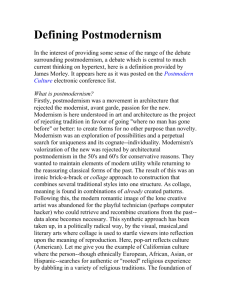Postmodernism Course Syllabus - HKU Fall 2005
advertisement
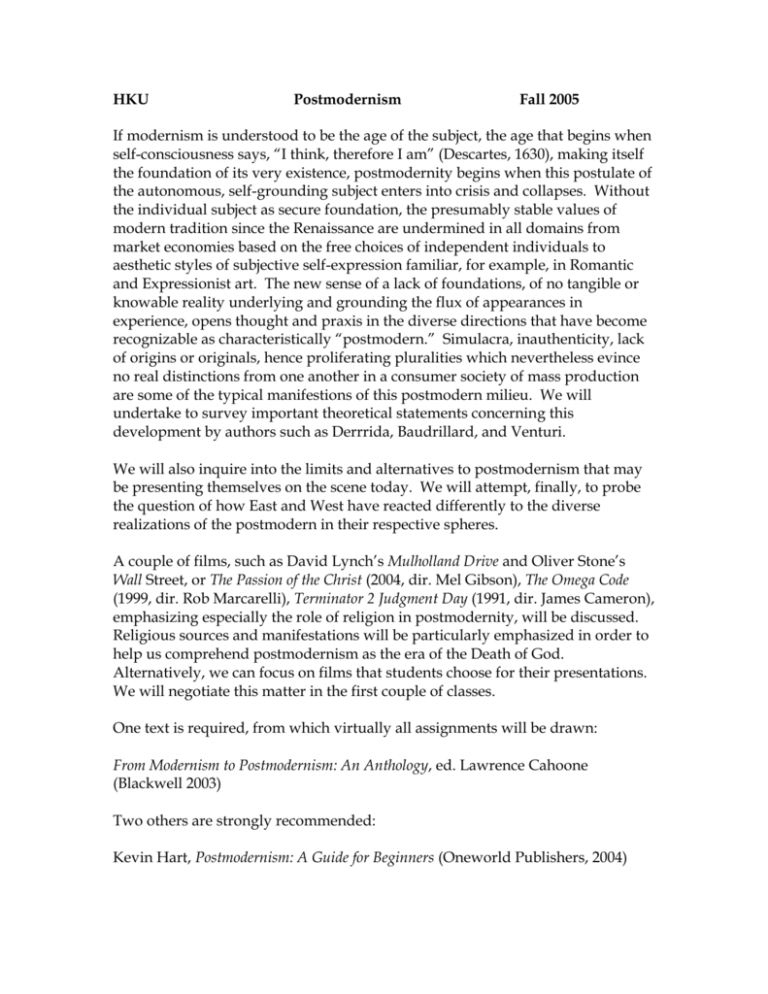
HKU Postmodernism Fall 2005 If modernism is understood to be the age of the subject, the age that begins when self-consciousness says, “I think, therefore I am” (Descartes, 1630), making itself the foundation of its very existence, postmodernity begins when this postulate of the autonomous, self-grounding subject enters into crisis and collapses. Without the individual subject as secure foundation, the presumably stable values of modern tradition since the Renaissance are undermined in all domains from market economies based on the free choices of independent individuals to aesthetic styles of subjective self-expression familiar, for example, in Romantic and Expressionist art. The new sense of a lack of foundations, of no tangible or knowable reality underlying and grounding the flux of appearances in experience, opens thought and praxis in the diverse directions that have become recognizable as characteristically “postmodern.” Simulacra, inauthenticity, lack of origins or originals, hence proliferating pluralities which nevertheless evince no real distinctions from one another in a consumer society of mass production are some of the typical manifestions of this postmodern milieu. We will undertake to survey important theoretical statements concerning this development by authors such as Derrrida, Baudrillard, and Venturi. We will also inquire into the limits and alternatives to postmodernism that may be presenting themselves on the scene today. We will attempt, finally, to probe the question of how East and West have reacted differently to the diverse realizations of the postmodern in their respective spheres. A couple of films, such as David Lynch’s Mulholland Drive and Oliver Stone’s Wall Street, or The Passion of the Christ (2004, dir. Mel Gibson), The Omega Code (1999, dir. Rob Marcarelli), Terminator 2 Judgment Day (1991, dir. James Cameron), emphasizing especially the role of religion in postmodernity, will be discussed. Religious sources and manifestations will be particularly emphasized in order to help us comprehend postmodernism as the era of the Death of God. Alternatively, we can focus on films that students choose for their presentations. We will negotiate this matter in the first couple of classes. One text is required, from which virtually all assignments will be drawn: From Modernism to Postmodernism: An Anthology, ed. Lawrence Cahoone (Blackwell 2003) Two others are strongly recommended: Kevin Hart, Postmodernism: A Guide for Beginners (Oneworld Publishers, 2004) William S.W. Lim, Altenative (Post-)Modernity: An Asian Perspective (Select Publishing) 1. Introduction: Postmodernism and its Others 2. Definitions Lyotard, From The Postmodern Condition A Report on Knowledge 259-77 Ihab Hassan, “POSTmodernISM: A Practical Bibliography” 410-20 Charles Jencks, From “What is Post-Modernism?” 458-63 David Hall, From “Modern China and the Postmodern West” 512-19 3. The Subversion of the Sign Ferdinand de Saussure, From Course in General Linguistics, 122-26 Jacques Derrida, “Différance” 225-40 Hal Foster, “Subversive Signs” 310-18 Wittgenstein, From Tractatus Logico-Philosophicus 143 4. Death of God and Demise of Values and Civilization Friedrich Nietzsche, “The Madman,” “How the World Became a Fable,” “The Dionysian World” 116-17 Michel Foucault, “Nietzsche, Genealogy, History” and From “Truth and Power” 241-53 Mark Taylor, From Erring: A Postmodern Atheology 435-46 Sigmund Freud, From Civilization and its Discontents 144-49 5. Simulations and Alterities Baudrillard, From Symbolic Exchange and Death 421-34 Jacques Lacan, “The Mirror Stage as Formative of the Function of the I as Revealed in Psychoanalytic Experience” 195-99 Deleuze and Guattari, From “1227: Treatise on Nomadology—The War Machine” 278-96 Emmanuel Levinas, “Meaning and Sense” 521-39 6. Postmodern Economy and Society Karl Marx and Frederich Engels, “Bourgeois and Proletarians” 75-82 Daniel Bell, From The Coming of Post-Industrial Society 209-18 Fredric Jameson, “The Cultural Logic of Late Capitalism” 564-74 Henry Giroux , “Towards a Postmodern Pedagogy” 383-89 7. Architecture and Humanism Le Corbusier, From Towards a New Architecture 132-38 Charles Jencks, From “The Death of Modern Architecture” 457-58 Robert Venturi, From Complexity and Contradiction in Architecture 403-9 Heidegger, “Letter on Humanism” 174-94 (continuation in #8) 8. The Attack on Humanism and Some Alternatives Jean Paul Sartre, From “Existentialism” 169-73 Alasdair McIntyre, “The Virtues, the Unity of a Human Life, and the Concept of a Tradition” 550-63 Habermas, “An Alternative Way Out of the Philosophy of the Subject: Communicative versus Subject-Centered Reason” 592-600 Immanuel Kant, “An Answer to the Question: ‘What is Enlightement?’” 45-48 9. Postmodern Feminisms Luce Irrigaray, “The Sex Which is Not One” 254-58 Sandra Harding, From “From Feminist Empiricism to Feminist Standpoint Epistemologies” 342-53 Susan Bordo, “The Cartesian Masculinization of Thought and SevententhCentury flight form the Feminine” 354-69 Judith Butler, “Contingent Foundations: Feminism and the Question of ‘Postmodernism’” 390-401 10. Race and Identity Iris Marion Young, From “The Scaling of Bodies and the Politics of Identity” 370-82 Cornel West, “A Genealogy of Modern Racism” 298-301 Gayatri Spivak, From “Can the Subaltern Speak?” 319-41 Hegel, “Absolute Freedom and Terror” 70-74 11. Postmodern Science: Irrealities and Hyper-realities Thomas Kuhn, From “The Nature and Necessity of Scientific Revolution” 200-08 Donna Haraway, From “A Manifesto for Cyborgs: Science, Technology, and Socialist Feminsim in the 1980’s” 464-81 David Ray Griffin, From “The Reenchantment of Science” 482-95 Niklas Luhmann, “The Cognitive Program of Constructivism and a Reality that Remains Unknown” 496-511 12. Reality and the Returns of the Repressed Max Weber, “Science as a Vocation” 127-31 W.V. Quine, “Epistemology Naturalized” 540-49 Richard Rorty, “Solidarity or Objectivity?” 447-56 Hilary Putnam, “Is There Still Anything to Say about Reality and Truth?” 592-600 Requirements and Evaluation The readings listed for each week’s class will form the basic material to be discussed in the lecture. In the preceding class, indications will be given as to which of these readings are absolutely required and which can be read more cursorily and selectively. All should be sampled and might be valuable for students in composing their essays, depending on the topic they choose. Two 5page essays are required. The first is to be handed in at the class following the mid-semester break and the second should be handed in on the last day of class. Each of the essays will be counted for 40% of the final mark. The remaining 20% will depend on a 10-20 minute presentation by the student (or in pairs) and on their participation in class throughout the course. The essays should make interesting arguments interpreting literature or film in light of certain theoretical concepts offered by the readings. They can also be arguments of a philosophical, historical, psychological, or sociological nature that work with some of the texts studied and with ideas pertaining to postmodernism. The important thing is for each student to write on a topic that is personally meaningful to them and to effectively convey this significance to a reader. Presentations should similarly select a topic of special interest to the individual student and discuss it in terms relevant to postmodernism. Students are welcome, for example, to present a film with some clips and a summary, along with an analysis of what issues are raised. We will then try to discuss together how they relate to other texts and materials that have been presented and discussed.
